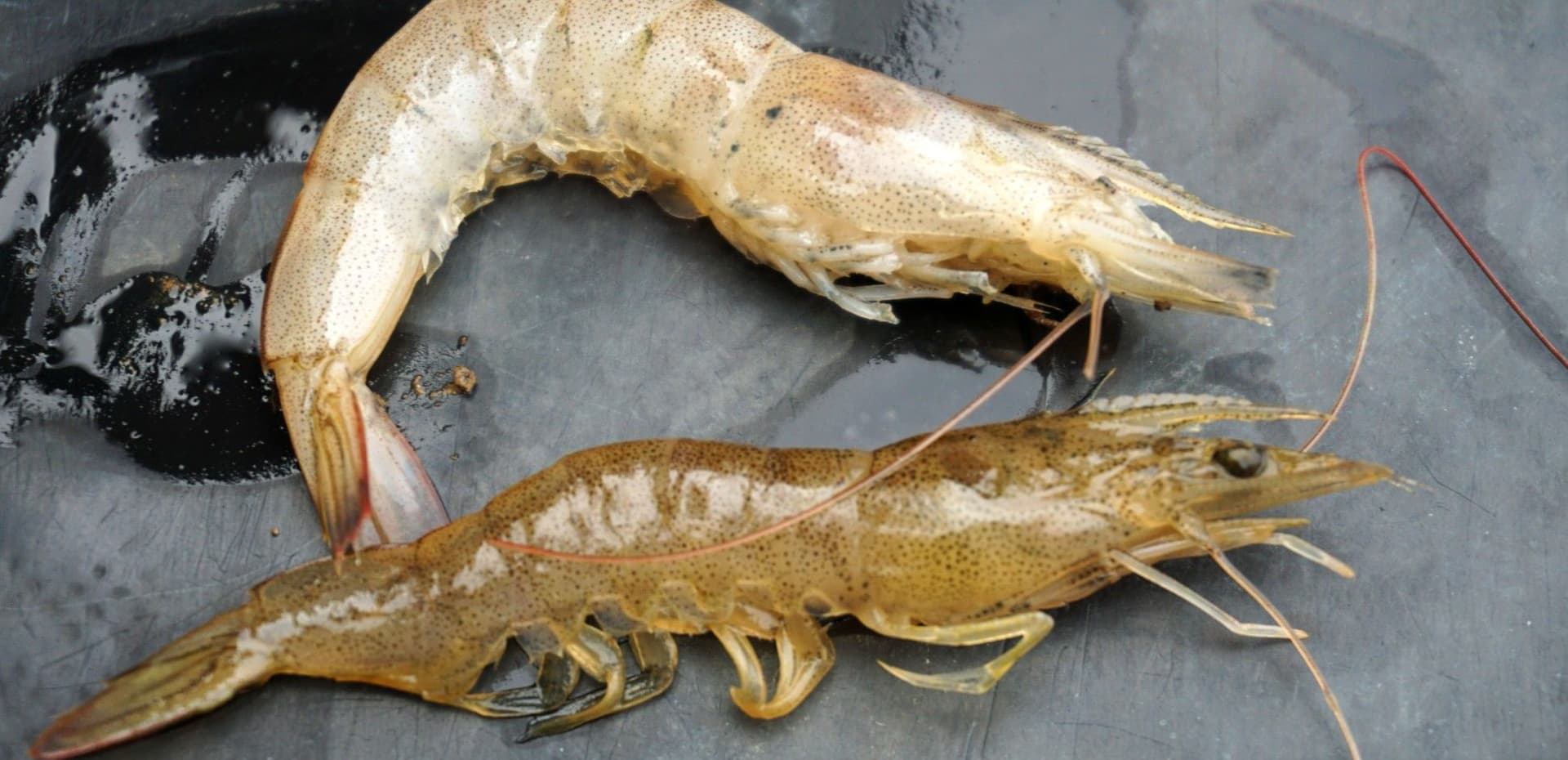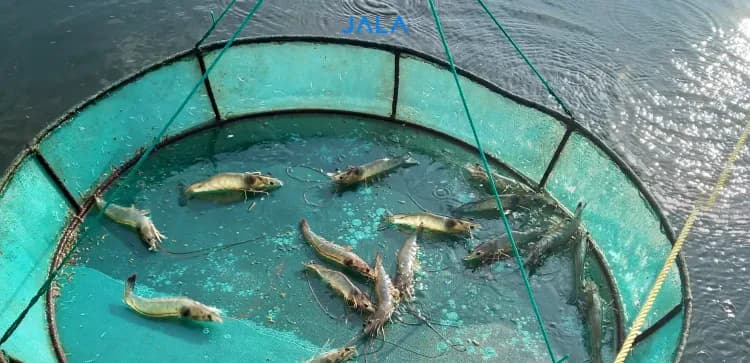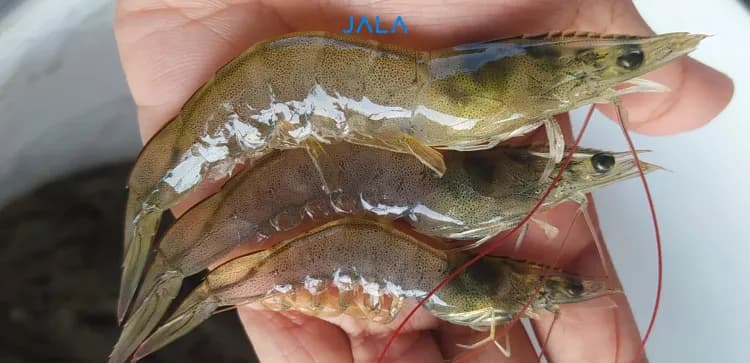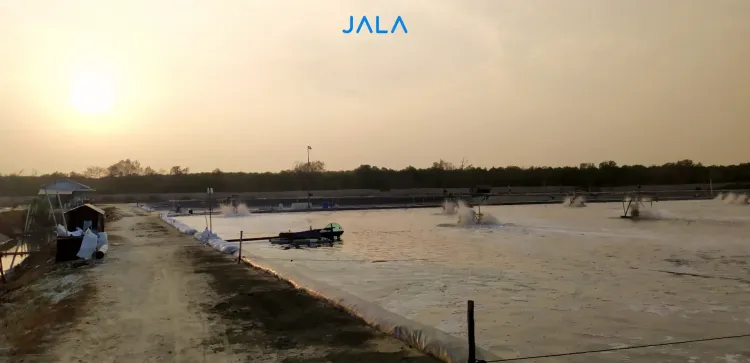
In running their shrimp cultivation, farmers are often faced with the threat of Acute hepatopancreatic necrosis disease (AHPND) and White Feces Disease (WFD), two of the most common diseases in shrimp farms. Mitigating shrimp diseases in the farm should involve regular water quality monitoring, a habit which farmers need to actively build. To equip farmers with better knowledge on vannamei shrimp disease and water quality, JALA held the SHRIMPS TALK online webinar on October 26 2023.
This time, the SHRIMPS TALK webinar was attended by 2 esteemed speakers: Sidrotun Naim, M.P.A, Ph.D (The Doctor of Shrimp & Aquaculture Scientist), who shared about Shrimp Disease Data Trends, and Dr. Supono, S.PI., M.Si. (Lecturer of the Department of Fisheries and Marine Sciences UNILA and shrimp farming practitioner), who shared about Important Water Quality Variables to be Watched Out For. 124 attendees participated in the webinar.
Shrimp Disease Data Trends

In the first session, Dr. Naim showcased the positivity rate trend for shrimp diseases. In general, several regions were hit by double infections of AHPND and EHP, while others were hit by WSSV and AHPND during the wet season. Moreover, the increase of IMNV is mostly seen in the western parts of Indonesia. EHP in Indonesia was first detected last December in Bangka and Sulawesi, and its cases later increased in several central cultivation areas.
Among different biotic and abiotic samples tested, shrimp had the highest positivity rate at over 24%. The highest positivity rate was seen during DoC 10-30. It is also important to note that live shrimp feed are potential pathogen carriers for shrimp fry.
Among different biotic and abiotic samples tested, shrimp had the highest positivity rate at over 24%. The highest positivity rate was seen during DoC 10-30. It is also important to note that live shrimp feed are potential pathogen carriers for shrimp fry.
Dr. Naim reminded shrimp farmers that vannamei shrimp diseases may cause huge losses for farmers. Data shows that in farms which are free from diseases, 90% of shrimp can survive and be harvested. Meanwhile, farms which encounter shrimp diseases can experience losses of up to 125%. Regular checking is essential in minimizing the risk of losses due to diseases.
In shrimp cultivation, there are several critical points which may be the entry point for shrimp diseases. Some points are easy to control, such as water, shrimp feed, and hatcheries. However, it's more challenging for farmers to do regular detection on their shrimp fry before stocking.
Important Water Quality Variables to be Watched Out For

For the second presentation, Dr. Supono shared that the surrounding environment plays a crucial role in ensuring shrimp health. Variables such as dissolved oxygen (DO), temperature, pH, and ammonia determine whether pathogens can survive in the farm. At the same time, an unfavorable environment causes shrimp to lose their appetite and experience stress, which weakens their immunity and makes them more susceptible to disease.
Read more: The Importance of Water Quality Monitoring and How to Read Its Results
Farmers need to be alert when several parameters change in their farm. For example, low temperature causes shrimp to lose their appetite. To mitigate the adverse effects of low temperature, farmers can maximize the use of paddlewheels.
The next variable to be watched out for is DO. Low DO can be characterized by shrimp floating on the surface of the pond and dead shrimp at the bottom of the pond. The application of dolomite can bind to excess CO2 and increase DO. Furthermore, pond water should be replaced regularly. Besides DO, pH is another parameter to be monitored. For pH control, farmers can avoid high pH by reducing phytoplankton density and increase water buffering capacity through the application of dolomite.
Aside from physical and chemical parameters, farmers should also monitor microbiological variables in their farm, such as blooming phytoplankton. Phytoplanktons are considered to be under blooming condition if their density reaches 100,000 cells/ml, which may occur due to overfeeding and poor feeding management. Blooming phytoplankton causes oversaturation of oxygen during the day and depletion during the night, which in turn might cause excessive ammonia and trigger mass mortality.
To mitigate this, farmers need to have better shrimp feed management and use high quality feed. Biofilters from nitrifying bacteria, water plants, tilapia, and mussels can also be used to absorb excess ammonia. Lastly, Dr. Supono also shared about the importance of installing a wastewater treatment plant to help reduce total organic matter (TOM), total suspended solids (TSS), and pathogens in pond water.
The 11th SHRIMPS TALK webinar brought many new insights to the attendees, who were eager to ask their questions relating to the topics presented. Through this series of discussions, JALA hopes to help farmers reach a more productive and sustainable cultivation.
If you are involved in the shrimp cultivation industry and want to improve your farm productivity with the latest information, tips, and insights, follow JALA’s Instagram at @jalaindonesia so you don’t miss the next SHRIMPS TALK and other upcoming events. See you in the next SHRIMPS TALK!





